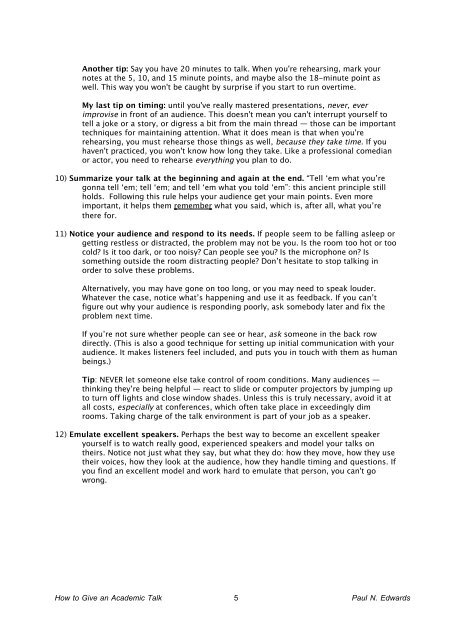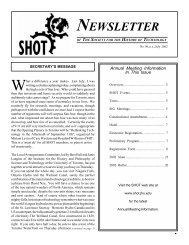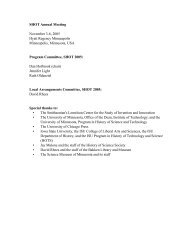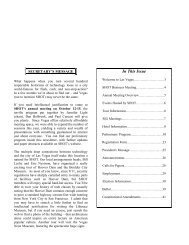How to Give an Academic Talk - Society for the History of Technology
How to Give an Academic Talk - Society for the History of Technology
How to Give an Academic Talk - Society for the History of Technology
You also want an ePaper? Increase the reach of your titles
YUMPU automatically turns print PDFs into web optimized ePapers that Google loves.
Ano<strong>the</strong>r tip: Say you have 20 minutes <strong>to</strong> talk. When you're rehearsing, mark your<br />
notes at <strong>the</strong> 5, 10, <strong>an</strong>d 15 minute points, <strong>an</strong>d maybe also <strong>the</strong> 18-minute point as<br />
well. This way you won't be caught by surprise if you start <strong>to</strong> run overtime.<br />
My last tip on timing: until you've really mastered presentations, never, ever<br />
improvise in front <strong>of</strong> <strong>an</strong> audience. This doesn't me<strong>an</strong> you c<strong>an</strong>'t interrupt yourself <strong>to</strong><br />
tell a joke or a s<strong>to</strong>ry, or digress a bit from <strong>the</strong> main thread — those c<strong>an</strong> be import<strong>an</strong>t<br />
techniques <strong>for</strong> maintaining attention. What it does me<strong>an</strong> is that when you're<br />
rehearsing, you must rehearse those things as well, because <strong>the</strong>y take time. If you<br />
haven't practiced, you won't know how long <strong>the</strong>y take. Like a pr<strong>of</strong>essional comedi<strong>an</strong><br />
or ac<strong>to</strong>r, you need <strong>to</strong> rehearse everything you pl<strong>an</strong> <strong>to</strong> do.<br />
10) Summarize your talk at <strong>the</strong> beginning <strong>an</strong>d again at <strong>the</strong> end. “Tell ‘em what you’re<br />
gonna tell ‘em; tell ‘em; <strong>an</strong>d tell ‘em what you <strong>to</strong>ld ‘em”: this <strong>an</strong>cient principle still<br />
holds. Following this rule helps your audience get your main points. Even more<br />
import<strong>an</strong>t, it helps <strong>the</strong>m remember what you said, which is, after all, what you’re<br />
<strong>the</strong>re <strong>for</strong>.<br />
11) Notice your audience <strong>an</strong>d respond <strong>to</strong> its needs. If people seem <strong>to</strong> be falling asleep or<br />
getting restless or distracted, <strong>the</strong> problem may not be you. Is <strong>the</strong> room <strong>to</strong>o hot or <strong>to</strong>o<br />
cold? Is it <strong>to</strong>o dark, or <strong>to</strong>o noisy? C<strong>an</strong> people see you? Is <strong>the</strong> microphone on? Is<br />
something outside <strong>the</strong> room distracting people? Don’t hesitate <strong>to</strong> s<strong>to</strong>p talking in<br />
order <strong>to</strong> solve <strong>the</strong>se problems.<br />
Alternatively, you may have gone on <strong>to</strong>o long, or you may need <strong>to</strong> speak louder.<br />
Whatever <strong>the</strong> case, notice what’s happening <strong>an</strong>d use it as feedback. If you c<strong>an</strong>’t<br />
figure out why your audience is responding poorly, ask somebody later <strong>an</strong>d fix <strong>the</strong><br />
problem next time.<br />
If you’re not sure whe<strong>the</strong>r people c<strong>an</strong> see or hear, ask someone in <strong>the</strong> back row<br />
directly. (This is also a good technique <strong>for</strong> setting up initial communication with your<br />
audience. It makes listeners feel included, <strong>an</strong>d puts you in <strong>to</strong>uch with <strong>the</strong>m as hum<strong>an</strong><br />
beings.)<br />
Tip: NEVER let someone else take control <strong>of</strong> room conditions. M<strong>an</strong>y audiences —<br />
thinking <strong>the</strong>y’re being helpful — react <strong>to</strong> slide or computer projec<strong>to</strong>rs by jumping up<br />
<strong>to</strong> turn <strong>of</strong>f lights <strong>an</strong>d close window shades. Unless this is truly necessary, avoid it at<br />
all costs, especially at conferences, which <strong>of</strong>ten take place in exceedingly dim<br />
rooms. Taking charge <strong>of</strong> <strong>the</strong> talk environment is part <strong>of</strong> your job as a speaker.<br />
12) Emulate excellent speakers. Perhaps <strong>the</strong> best way <strong>to</strong> become <strong>an</strong> excellent speaker<br />
yourself is <strong>to</strong> watch really good, experienced speakers <strong>an</strong>d model your talks on<br />
<strong>the</strong>irs. Notice not just what <strong>the</strong>y say, but what <strong>the</strong>y do: how <strong>the</strong>y move, how <strong>the</strong>y use<br />
<strong>the</strong>ir voices, how <strong>the</strong>y look at <strong>the</strong> audience, how <strong>the</strong>y h<strong>an</strong>dle timing <strong>an</strong>d questions. If<br />
you find <strong>an</strong> excellent model <strong>an</strong>d work hard <strong>to</strong> emulate that person, you c<strong>an</strong>'t go<br />
wrong.<br />
<strong>How</strong> <strong>to</strong> <strong>Give</strong> <strong>an</strong> <strong>Academic</strong> <strong>Talk</strong> 5<br />
Paul N. Edwards





